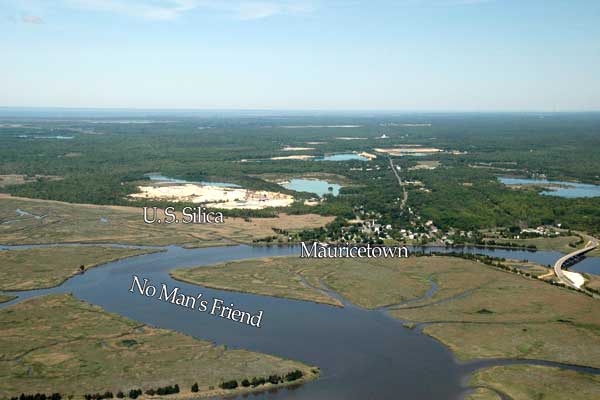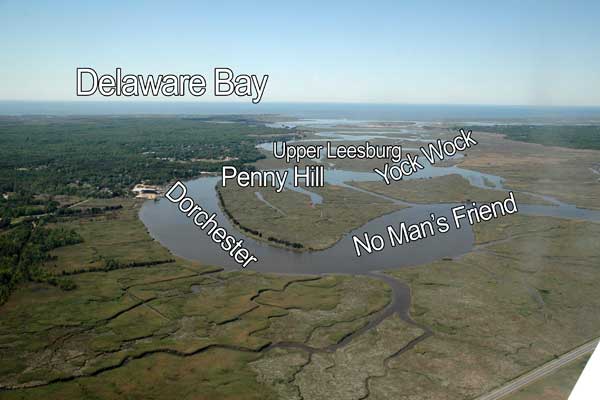The Maurice River Reaches Project
No Mans Friend
Reach #34
 The fate of an ancient ship. The glorious age of great sailing ships. And a pirate, too?
The fate of an ancient ship. The glorious age of great sailing ships. And a pirate, too?
The legend and lore of No Man's Friend stirs the imagination. While very few people attach a name to this particular reach on the Maurice River today, there's a bit of intrigue about the history of this old reach name.
Local historian Herbert Vananam was captivated by the lore, even as a youngster. Vanaman was traveling on the Maurice River on one of his boyhood adventures with his grandfather. "We were somewhere between Mauricetown and Dorchester in the reach of the river called No Man's Friend," Vanaman wrote. He recalled how his grandfather spoke to him of an ancient ship that entered the Maurice River from the Delaware Bay. That ship met an unspeakable fate. It was set ablaze by the Indians right near where Vanaman and his grandfather were traveling that day. Vanaman's grandfather said that the ship was called the Prince Maurice - and that the river had been named after this vessel.
In his article, A River of Many Names, an Ancient Ship and Disaster, Vanaman investigated the story that many fathers, grandfathers and uncles passed down to the younger generations. In his writings, Vanaman makes a pretty good case for an ancient vessel running into trouble and being abandoned right there in No Man's Reach. He doesn't buy into the idea that Native Americans would have caused the demise of the ship. But interested parties will have to read between those lines for themselves. Vanaman does offer evidence that points to engine trouble - well, not exactly engine trouble since this wind-powered vessel traveled the Whahatquenack (the Lenape name for this tributary of the Delaware River) in the mid-1600's.
 Vanaman's interest in the history of the Maurice River followed him into adulthood. He became one of the area's most-esteemed historians.
Vanaman's interest in the history of the Maurice River followed him into adulthood. He became one of the area's most-esteemed historians.
After thorough research on this topic, Vanaman concluded that the ship, the Prince Maurice, had indeed been abandoned. Vanaman provided this account, given in 1867 by Dr. Lorenzo Fisler of Port Elizabeth: "Dr. Fisler's account mentions that he, as a boy, used to fish from the wreck of a large ship lying in No Man's Friend." Fisler's account noted that, at the time of his boyhood in 1790, even the eldest resident in the Maurice River valley did not know how or when it got there. "Dr Fisler did attach the legend of the Prince Maurice to this wrecked vessel," Vanaman wrote, and added, "Another old resident stated that the ship had a very tall stern post." This provides evidence that the sunken vessel was from another era.
In his article, Vanaman related his grandfather's explanation of the name No Man's Friend. He wrote: "During the days of the coastal schooners that plied this stream in great numbers in the mid-eighteen hundreds carrying cargo in and out, the vessels sailing into the river had great difficulty in passing this reach due to the course of the river here, northwest and southeast. Hence the name 'No Man's Friend'."
Local resident Everett Turner spent a good amount of time with Vanaman. "Herb had knowledge that I have heard no one speak," Turner said. "Just below the Mauricetown Bridge, on the east side of the river, there was a place they called Devaul's Island. Herb showed me where it was," Turner said conspiratorially. "There were legends that Devaul was a pirate and had buried treasures on the big sand hill there," he said, referring to No Man's Friend Reach. "Did you ever hear of the (ship) Prince Maurice? Well, that is right at that same reach."
The Reeves family was familiar with No Man's Friend. In his book, Maurice River Memories, Joseph Reeves, Jr. wrote about one outing in August 1938. Reeves and his father, Joseph, Sr., headed out on the Maurice River to collect driftwood that would be used for heat in the coming winter. They rowed their bateau down river, nearing the west bank as the river "curved northeastward into Noman's Friend Reach" (his spelling). Much of the driftwood they picked up in the "rushes growing near the riverbank" was scrap lumber from the shipyards in Mauricetown, Dorchester and Leesburg. When they came around the bend to Dorchester, they spotted the 90-foot Navy submarine chaser that was being built there.
Joseph Reeves, Jr. related that, based on his experiences, Noman's Reach was aptly-named. In his book, he wrote of an outing in April 1941. He and his dad were working with a two hundred-foot drift net. Reeves wrote, "No sooner did we get the two hundred foot drift net placed across the river than the swirling currents displaced it." Reeves detailed the way the fast moving current "on the north side of the reach" made it difficult to maintain the taunt barrier that would trap the roe shad that were beginning to make their run upriver. Reeves observed that the skill, physical strength and endurance of his dad and the generations of fishermen before are what it took to be successful watermen on this winding waterway.
 click to navigate the map "up".
click to navigate the map "up". click to navigate the map "down".
click to navigate the map "down". click to navigate the map "left".
click to navigate the map "left". click to navigate the map "right".
click to navigate the map "right". click to "zoom in" for a closer look.
click to "zoom in" for a closer look. click to "zoom out" to back away from the map.
click to "zoom out" to back away from the map. click to get back to the "default" map setting.
click to get back to the "default" map setting. click to learn more about that reach.
click to learn more about that reach.
